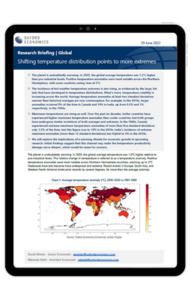Shifting temperature distribution points to more extremes

The planet is undoubtedly warming. In 2020, the global average temperature was 1.2°C higher than pre-industrial levels. Positive temperature anomalies were most notable across the Northern Hemisphere, with some countries seeing rises of 2°C. The incidence of hot weather temperature extremes is also rising, as evidenced by the large, fat tails that have developed in temperature distributions. What’s more, temperature volatility is increasing across the world.
What you will learn:
-
Average temperature anomalies at least two standard deviations warmer than historical averages are now commonplace.
-
Maximum temperatures are rising as well. Over the past six decades, hotter countries have experienced higher maximum temperature anomalies than cooler countries, but both groups have undergone similar evolutions of both averages and extremes.
-
We will explore the implications of a warming climate for economic growth in upcoming research.
Tags:
Related services

Service
Country Climate Analysis
Assess the impact climate change will have on all facets of your business. Now and in the future.
Find Out More
Service
Global Risk Service
A suite of data-driven and forward-looking tools that provide an objective and transparent measure of risk.
Find Out More
Service
Global Economic Model
Our Global Economic Model provides a rigorous and consistent structure for forecasting and testing scenarios.
Find Out More